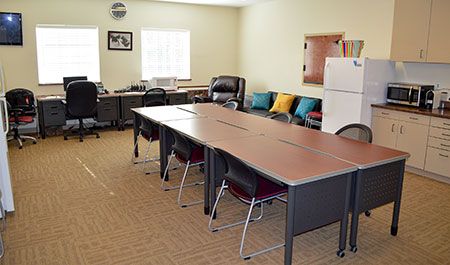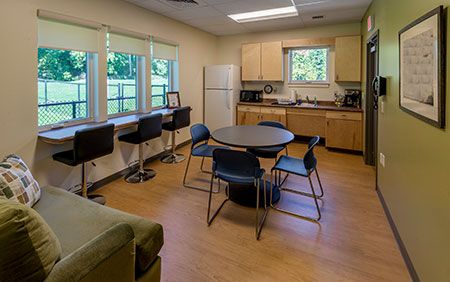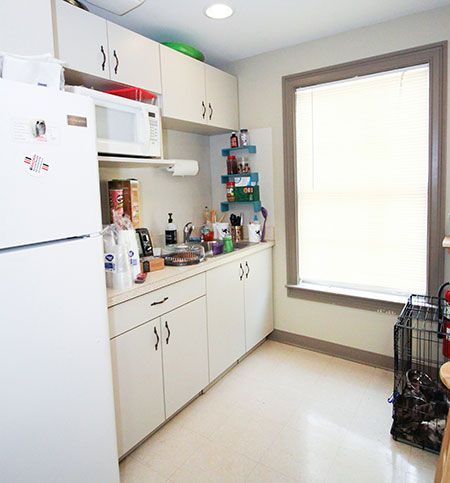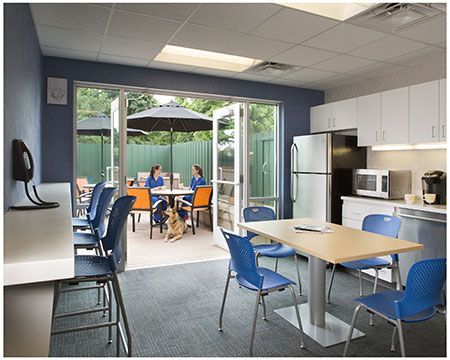Dont break your break room
You need to save money, but are you sure your veterinary hospital break room needs to be a dark, cramped closet? Remember: The same people who made your practice so successful in the first place are going to be using that room.
When time and budget get crunched, the break room is one space that sometimes gets features cut first in new or remodeled veterinary hospitals. But your culture and your vision for your practice may involve care for staff and the need for a place to unwind and take a breather between rough emotional cases. Remember: The same people who made your practice so successful in the first place are going to be using that room. Take a look at how to fix your dark, dreary space.

A 2017 dvm360 Hospital Design People's Choice winner, Carolina Ranch Animal Hospital & Resort in Garner, North Carolina, included this break room with flexible seating / Primary architects: Will Marshburn, Brian Griffith, Bobbit Design Build (Photo courtesy of Paul Potera)Building new? Don't skimp on size
When designing a veterinary hospital, practice owners and architects alike can sometimes put on blinders and not allow enough space in our floor plans for staff break areas. You want enough space in your break area for kitchen equipment (fridge, dishwasher, sink, microwave and vending machine) along with adequate space to sit and relax. Be careful to place your fridge near the entry into the break area but not right at the door. Make it easy both for traffic in and out of the break room as well as people quickly grabbing something out of the fridge and heading back out on the floor.

Staff lounge at Petit Brook Veterinary Clinic in Colchester, Vermont / Primary architect: Bob Duncan, Duncan-Wisniewski Architecture (Photo courtesy of Gary Hall, Gary Hall Photography)Building new or remodeling? Vary the seating
You need adequate space and variation, so team members can choose where they want to be on their break. Some people love to be social and want to sit with their friends and peers; others may want to curl up in a chair in the corner and spend a few minutes reading a book. Break rooms aren't just kitchens, but lounges to encourage a few minutes of diversion and distraction from the stress of the day. Tables for smartphone or laptop web surfing or comfy chairs with TVs can also make for a more successful break room.

Staff lounge at Rose Animal Hospital in Roswell, Georgia / Primary architect: Shawn Rainey, Blue Frog Construction (Photo courtesy of Jennifer Wettstein, Wettstein Photography)Building new or remodeling? Let the sunshine in
Medical spaces in veterinary hospitals tend to be in the center of the buildings with little to no natural light. Open your break room up to the sun to draw in your staff! Views out to a landscaped patio or yard area can provide a nice respite. Even if you only have an exterior door to work with in your existing break room, consider replacing that solid door with a full glass door to add natural lighting. No exterior door or window? No problem. Add a tubular skylight to let the light in.

A 2017 dvm360 Hospital Design Competition Merit Award winner, Village Veterinary Clinic of Hamburg in Hamburg, New York, sports a break room with a view / Primary architect: Mark Hafen, Animal Arts (Photo courtesy of Tim Murphy, Murphy Foto Imagery)Open to the outdoors
Even in typically cold or hot climates, it's worth providing team members with an outdoor space to get away-even for a few minutes. The area should be directly off the interior break room and can even have a grill to encourage staff to cook outside. Shading devices, privacy walls and seating options are key to a successful outdoor patio. This space could even be used for team building events. If you can do it, consider adding a garage door to your break room to double the size of your break area and to add both natural light and air into your break space.
Whether it's space, light, comfortable seating or a place to get some fresh air, veterinary team members who can get a break when they need it can come back refreshed and ready. Break rooms can help.
Vicki Pollard is a certified veterinary technician and veterinary architect at Animal Arts in Boulder, Colorado, and has spoken at the HospitalDesign360 Conference that runs with Fetch dvm360 in Kansas City.